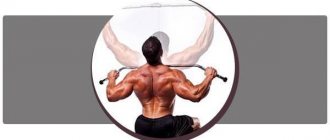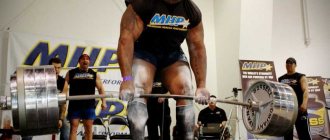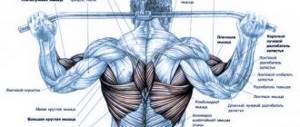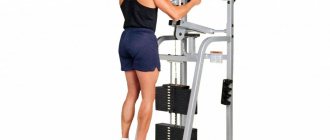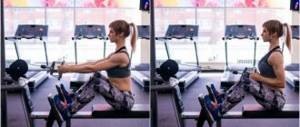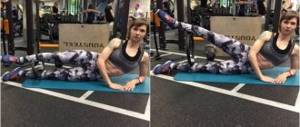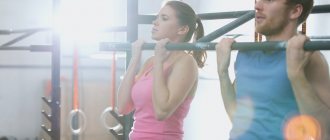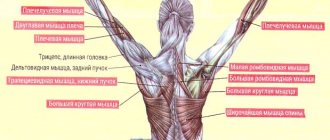Bent-over barbell rows (forward and reverse grip) are a basic exercise in powerlifting and bodybuilding. Used to develop the back muscles, it significantly improves the overall level of the athlete.
The exercises are intended to be performed by intermediate and advanced athletes, but can also be performed by beginners.
It should be performed at the beginning of back training - when there is no fatigue yet. After the barbell row at an angle to the waist has been completed, you can proceed to other types of rows: horizontal, vertical, etc.
What muscles are involved?
Bent-over barbell rows are a basic exercise for growing the teres major and latissimus muscles, as well as the posterior deltoid muscles.
The latissimus muscles are large muscles of the back that cover the back from below and in the middle. These muscles look especially impressive when an athlete poses; they are also one of the main ones that influence the overall strength of the athlete.
The teres major muscles are located near the upper lateral portions of the latissimus muscles.
The deltoid muscles (posterior bundles) are located behind the shoulder joints.
When performing the exercise, the trapezius and rhomboid back muscles are involved. The trapezius is found in the middle of the back, starting at the base of the skull and extending to the middle of the spine and to the shoulders. The rhomboids are located in the middle of the back next to the trapezius muscles.
You can emphasize the load on different areas of the back by changing the width of the grip, as well as changing the angle of the body.
Analysis of the exercise
Anatomy of exercise - which muscles work
Benefits of Exercise
Flaws
Preparation for execution
Perform a block of standard warm-up exercises, supplementing it with aerobic exercise for 5 minutes. To achieve a deep enough bend in the exercise, you need to spend time separately stretching the hamstrings and ankle.
Attention: before performing the exercise, it is not recommended to heavily load the rectus dorsi muscles, since they bear the main burden of holding the body in a static position.
Proper execution
Errors
Efficiency Tips
Inclusion in the program
The barbell row, as a heavy basic exercise, deserves to be performed among the first in back training. Choose a weight with which you are able to perform 10-12 repetitions and try to complete 3-4 sets in this mode. When working in strength mode, stick to the low rep range (3-5 reps/1 set).
The exercise will fit well into a split program that involves joint training of the back and biceps muscles.
The combination of classic deadlifts and reverse grip deadlifts allows you not only to diversify your workouts, but also to “cover” a larger area of the back muscles: with a direct grip, the upper areas of the lats are more activated, and with a reverse grip, their lower areas are more activated.
Contraindications
Performing the exercise can be dangerous if you have problems with the shoulder joints, both of a traumatic nature and with degenerative changes.
For those athletes who have recently injured their lower back or those who have serious problems with posture, hernias or protrusions, we recommend performing barbell rows to the waist with a reverse grip from a support that will provide reliable support for the body and spine.
How to replace the exercise
Conventionally, the bent-over row of a barbell can be replaced with a horizontal row while seated to the waist in a block simulator (as an option, a rowing machine), since the main loaded areas are the same. However, working with free weights is many times more effective for building muscle mass, while “block” deadlifts are more suitable for final muscle development.
As a possible alternative, you can also use dumbbell rows or T-bar rows, but the biomechanics of these exercises will be slightly different.
In principle, deadlifts can also be performed using a Smith machine, but in our opinion, this is not the most technically convenient option. Performing deadlifts in this case complicates the stationary trajectory of the bar.
Bent-over barbell row exercise options
The exercise is performed in the following variations:
- straight grip;
- reverse grip;
- different grip.
When performing the exercise with a direct grip, a good load on the latissimus muscles is provided, but for many, especially beginners, it is very difficult to maintain the correct trajectory of movement.
With a reverse grip, it is easier to maintain the trajectory, this is a more comfortable position, however, with it the biceps is included in the work and the ligaments are heavily loaded.
When performing the exercise with a different grip, better retention of the bar is ensured when choosing a very heavy weight.
What muscles work
When performing bent-over dumbbell rows, the following are involved:
- trapezoidal;
- teres major and minor muscles;
- diamond-shaped;
- latissimus dorsi muscles;
- and the back extensors are also involved in the work.
In addition to the back muscles, when extending the elbows, the following are involved:
- posterior bundles of deltoid muscles;
- shoulder biceps;
- forearms.
Execution technique
The exercise is performed as follows:
- You need to stand in front of the barbell with your feet shoulder-width apart. Bend your legs slightly at the knees.
- Bend over and take an overhand grip, placing your hands slightly wider than your shoulders. Do not bend your elbows.
- Straighten up and lift the barbell.
- Take the starting position, bending slightly at the waist, tilting your torso forward, the angle of parallel with the horizontal is 30 degrees, your head is looking forward, your knees are slightly bent. The lower back muscles are tense, the bar is located in front of the shins. Until the end of the approach, the starting position is maintained.
- Taking a shallow breath, hold your breath. Without moving your elbows to the side and up, keeping them moving straight back, pull the barbell towards your stomach, trying to raise your elbows up. The barbell stretches only due to the work of the muscles of the shoulders and back.
- The lower back muscles should remain tense until the end of the set.
- After pulling the barbell up, exhale and lower it to the floor in a smooth motion.
- Each repetition is performed in the same way.
Bent-over barbell row with reverse grip
Allows you to pump well the bottom of the latissimus muscles, the bottom and middle of the trapezius muscles. A basic exercise to thicken the muscles in the middle of the back.
Performance:
- The starting position is the same - with your knees slightly bent and shoulder-width apart, stand in front of the barbell. Take with a reverse grip, arms wider than shoulder-width apart, and lift the barbell with your torso straight.
- Further execution of the exercise is similar to the straight grip.
- When performing the exercise with a reverse grip, the elbows can rise strictly vertically, while when using an overhand grip, they are provoked to spread to the sides. Therefore, with a reverse grip, the correct form of movement is easier to maintain.
Errors during the exercise
The most common mistakes athletes make when performing an exercise:
- Movements of the legs, head, body. These parts of the body must be motionless.
- Unstable position on the floor. It is necessary to keep your feet shoulder-width apart, otherwise you will not be able to firmly take the correct position during the exercise.
- Incorrect distance between the hands: it should be wider than the shoulders, which provides greater amplitude with the elbows raised up.
- The beginning of the exercise is accompanied by a maximum load on the bottom of the latissimus muscles, but after the elbows pass the level of the back, the shoulders are pulled back, the load goes to the top of the latissimus, rhomboid and trapezius muscles.
- The curve of the spine should be natural and not change throughout the entire exercise. Many people do not hold the pose with their chest out and their back slightly arched in the lower back. Slouching is unacceptable and dangerous.
- Too heavy a weight will not allow you to perform the exercise correctly.
You cannot straighten your legs; they should always be slightly bent.
Common Mistakes
The waist row is an exercise characterized by the following technical errors:
- The slope is not deep enough. In principle, this is not harmful to the back and lower back, but it will not be possible to pump up the muscles efficiently.
- Hand pull. If you feel your biceps working during the exercise, this is wrong. The shoulder blades should be clearly felt.
- Rounding of the back and/or arching in the lower back. This is already dangerous. Therefore, before you begin deadlifting, you need to develop flexibility in your spine.
- Bending of the wrists. The arm should be straight from the elbow to the wrist. The load on bent hands increases, and the amplitude of lifting, on the contrary, decreases.
- Insufficient elbow lift. When the bar is raised to the stomach, they should be above the lower back.
- Incorrect weight. Too big simply does not allow you to bring your shoulder blades together, and too small will not give the desired effect.
- Incorrect breathing technique. Exhalation should occur strictly at maximum physical effort. It is also wrong to try to raise and lower the barbell in one long breath.
- Working with an overly narrow grip. In this position it is simply impossible to use the latissimus muscles.
Experienced athletes do not recommend using a weightlifting belt or wrist bandages when working with a barbell. This slows down progress and interferes with the development of grip strength. It is better to work with lighter weights, waiting until the muscles are strong enough.
By regularly performing bent-over barbell rows, you can strengthen the muscles of your upper back in a relatively short time. The same exercise allows you to create visual volume and massiveness of the torso. In addition to working out the muscles, it is useful for increasing overall strength endurance. Of course, a positive effect can only be expected if it is performed correctly, so you must first master the technique.
An insufficiently deep bend when performing rows to the belt will not allow you to pump up your muscles properly.
It is important to choose the right weight: too much weight will not allow you to bring your shoulder blades together, too little weight will not give the desired effect.
Regular training will not only strengthen the muscles of the upper back, but will also increase overall strength endurance.
Tips for performing the exercise bent over barbell row
- The torso, head, legs must remain motionless during execution. It is advisable to achieve an angle of inclination between the back and the horizontal of 45 degrees.
- The barbell is pulled by the muscles of the shoulders and back; the biceps do not work. The elbows should be directed upward from behind, due to which the arms bend.
- You should try to raise your elbows higher. The upper part of the latissimus muscles, the rhomboid and trapezius muscles work fully only after the elbows pass the level of the back. The shoulders are pulled back during execution.
- Do not use very heavy weights, as this may damage your technique. You will be trying to lift the barbell using your entire body, when your back muscles should be working. If the weight is too heavy, the elbows will not rise above the level of the back.
- When performing the exercise, the head should look forward. It is permissible to tilt it slightly, setting the gaze only slightly below the horizontal parallel. If you tilt your head too much, your gaze will be directed to the floor, which will lead to a dangerous rounding of your back.
- The exercise is recommended as a basic exercise for athletes of average and high levels of training.
- Perform the exercise at the beginning of the back complex. Once completed, you can perform vertical and horizontal rows.
- The number of repetitions in a set is 6-10, the number of approaches is 3-4.
Bodybuilding and fitness are activities that cannot be done without strength training on machines. In this sense, the seated pull-down is a universal exercise, used with equal success in both places.
The seated lat pulldown is a classic exercise for strengthening the back.
Basic
The main group includes targeted muscles included in the spinal mass, also called antagonists due to the performance of opposite anatomical functions. In this case, the pressing movements of the pectoral muscles are opposed to the traction movements of the spinal muscles.
The main load falls on the latissimus muscles, as well as the rear deltoids.
Bodybuilding is largely built on antagonistic movements, which, due to the ideal combination of these muscles, allow them to be used effectively at the same time.
To some extent, the main muscles for pulling power movements in a sitting position also include the spinal extensors, middle and lower trapezius, rhomboids, teres (major and minor) muscles, brachialis and brachiaradialis, sternal head and infraspinatus muscles.
Additional
The long head of the triceps and biceps (dynamic stabilizers), as well as muscles - simple stabilizers are also involved:
- adductor femur;
- gluteus maximus;
- hamstrings.
The full muscle layout can be seen in the diagram.
Adviсe
The back is the “lucky owner” of the following muscles:
- The latissimus muscles occupy the entire lower back. This area is a source of particular pride for strength training fans. Actually, their increase (hypertrophy) makes the back visually wider and stronger.
- The location of the rhomboid muscles is on both sides of the spine, slightly below the shoulder blades. Together with the small muscles, it gives the back relief.
- The teres major muscles are located slightly below the shoulders, starting from the superficial borders of the shoulder blades and the fascia of the infraspinatus muscle.
- The posterior group of deltas, which is practically not included in the work when performing other exercises.
- The trapezius muscles are located in the central area of the back and back of the neck.
- The erector spinae muscle is the most superficial muscle among the deep-lying back muscles.
- Biceps (biceps brachii).
The bent-over barbell row engages these muscles to work in sync. The exercise has the same super-powerful effect as deadlifts, squats, presses and is necessary for everyone who wants to “grow” their back muscles.
Stretch value
Unlike the bench press, where the terrible quality of stretching will in no way affect the technique of execution, here the stretching should be excellent, since the starting position assumes sufficient flexibility of the lumbar region and back. When performing, the lower back should bend, which means that before starting training, it is important to achieve the maximum possible stretching of this zone.
Lack of stretching will interfere with taking the correct position; therefore, it will be impossible to do the exercise correctly. Precise execution means measured, carefully controlled movements!
- The torso, head, legs must remain motionless during execution. It is advisable to achieve an angle of inclination between the back and the horizontal of 45 degrees.
- The barbell is pulled by the muscles of the shoulders and back; the biceps do not work. The elbows should be directed upward from behind, due to which the arms bend.
- You should try to raise your elbows higher. The upper part of the latissimus muscles, the rhomboid and trapezius muscles work fully only after the elbows pass the level of the back. The shoulders are pulled back during execution.
- Do not use very heavy weights, as this may damage your technique. You will be trying to lift the barbell using your entire body, when your back muscles should be working. If the weight is too heavy, the elbows will not rise above the level of the back.
- When performing the exercise, the head should look forward. It is permissible to tilt it slightly, setting the gaze only slightly below the horizontal parallel. If you tilt your head too much, your gaze will be directed to the floor, which will lead to a dangerous rounding of your back.
- The exercise is recommended as a basic exercise for athletes of average and high levels of training.
- Perform the exercise at the beginning of the back complex. Once completed, you can perform vertical and horizontal rows.
- The number of repetitions in a set is 6-10, the number of approaches is 3-4.
We recommend you:
- Bench push-ups
- Seated barbell press with reverse grip
- Seated dumbbell press
- Crunches lying on the floor
- Raising arms to the sides in the simulator
- Don’t chase a high working weight - first try to understand the exercise, feel all the muscle groups, achieve working out each of them by changing the type and width of the grip, and tilting the body. An excessive increase in the weight of the barbell leads to a sharp increase in the load on the biceps, which are assistants in this exercise and should not work instead of the back muscles.
- Keep your back straight, maintaining a slight arch in your lower back throughout the exercise. Remember, all deadlifts are extremely traumatic exercises for the lower back muscles and the spine as a whole.
- Try not to change the position of your head during the pull, do not turn your head to the sides - look straight ahead just above your eye line - this will allow you to keep the position of your back unchanged.
- Watch a video on the Internet demonstrating the correct technique for rowing a barbell.
- In general, the exercise is a strength exercise, therefore, execution involves a working weight of 60% of the maximum one-time weight with the expectation of 6-10 repetitions for 3-4 sets.
- Pull the barbell as you exhale, lower it as you inhale. This allows you to stretch the chest and along with it the back muscles at the lowest point, and bring the shoulder blades together at the highest point.
- Monitor your health. If you experience the slightest discomfort or pain in muscles or joints, it is recommended not to continue doing this exercise - replace it with a less traumatic one or consult a doctor.
Bent-over barbell rows are one of the most difficult exercises, but at the same time one of the most effective and comprehensive for the development of back muscles. If you follow these tips, the result will not be long in coming - your overall fitness and results in basic strength exercises will noticeably increase along with your latissimus, rhomboids and trapezius back muscles.
Exercise options and technique
The exercise can be performed in several variations. The main difference: wide and narrow grip. We recommend trying both options to understand which muscles receive more load.
Wide-grip lower block row to the waist
The peculiarity of using a wide handle for seated rows with arms raised to its edges is, first of all, that it is possible to move the shoulder blades further. In addition, the bend on such a handle allows you to increase the amplitude of the compression movement. The hands extend further than the chest, that is, further than the ribs. In any case, due to the increase in amplitude, the shoulders are pulled back to a greater extent - this is precisely the advantage that is given by pulling the lower block to the belt with a wide grip.
Pulling the wide handle is carried out not to the stomach, as in the classic movement, but to the chest, and the elbows move through the sides at the height of the handle itself.
Pull-down of the lower block to the waist with a narrow grip
The closer the grip, the more convenient it is to do the exercise. Therefore, every tenth person training on the simulator prefers to use a narrow grip when pulling the lower block to the waist while sitting.
To begin with, a consistent description of the classic technique of pulling the lower block to the stomach
(it is to this that the handle is pulled when pulling with a narrow grip), a characteristic feature of which is the static position of the back, without dynamics in the lower back.
- At the starting point, the arms are straightened without bending the torso forward, the knees are slightly bent, and the legs are supported.
- A traction movement is performed towards the abdomen, during which the shoulder blades move back and are brought together. Pull with your shoulder blades, not your arms, and keep your back straight.
- After this, straighten your shoulder blades again, but throwing the handle of the exercise machine. Allow your shoulders to stretch forward and stretch your back muscles.
- After straightening the arms, the beginning of the movement is repeated (while exhaling).
The hands in the classic version move smoothly, stopping at the extreme point (the inner parts of the palms touch the ribs) while simultaneously retracting the shoulder blades.
When you finish the exercise, be sure to release the weight with a straight back. You can either lean forward and give up the weight, or loosen the support in your knees, the weight will pull you forward along the bench until the plates are in place. In any case, keep your back straight to avoid injury.
There are other modifications of the narrow-grip row in stock:
- the back is still straight, but dynamics appear in the lower back (this option is also within the classic one);
- reverse (backs of palms down) narrow grip of a wide handle (other technical details remain unchanged) - this movement is more convenient for the hands, since the biceps are connected to it;
- narrow grip of a wide handle from above - used to simulate a bent-over barbell row. Since not everyone uses the barbell in the gym, this type of exercise is rare.
With a narrow grip, the muscles of the lower back work more intensely, and with a wide grip, the muscles of the upper back work more intensely.
Pulldowns from a seated position with one hand perfectly replace boring games with weights and dumbbells.
Performed with each hand in turn. The free hand is placed on the thigh or on the side bone.
The principle of the movement is the same as the bent-over dumbbell row: as you exhale, the block is pulled towards you (while simultaneously rotating the hand to the position of the palm facing upward), and in the meantime the shoulder blade is contracted on the back. Only one shoulder blade works, specifically directing the load to the latissimus muscle. The reverse movement is done while inhaling.
Despite the weight of the block being no less than that of a barbell or dumbbell, the effectiveness of such traction is no less.
Features and benefits of the exercise
Bent-over barbell rows provide a comprehensive workout for the following back muscles:
- Latissimus (the area between the elbows and the body). They take on the main load. They are the ones who give the back its characteristic V-shaped appearance and are responsible for its width.
- Diamond-shaped (under the shoulder blades to the right and left of the spine), large round (run along the upper edge of the shoulder blade, almost following the contours of the shoulder) and trapezoidal (the area between the cervical and thoracic spine). They work secondarily. They help bring your shoulder blades together when performing the exercise, lifting the weight as high as possible.
- Biceps, rear deltoids. They take on a small part of the load, participate in bending the arms and moving the elbows back.
- Spinal extensors, abdominal muscles. They play the role of stabilizers, helping to maintain the correct position of the body.
Knowing which muscles work when performing the exercise, it is easy to understand that it is useful not only for men who want to build up a beautiful figure. For them, it is one of the basics, but lifting a barbell while standing in an inclined position is recommended for everyone who needs to improve their posture and strengthen the muscular corset of the body. Later, this corset will serve as an effective prevention of problems with the musculoskeletal system.
Bent-over barbell lifts are useful for the following:
- increasing overall muscle strength and endurance;
- improving lumbar flexibility;
- restoration and maintenance of correct posture;
- promoting progress in other strength exercises (for example, deadlifts and bench presses);
- burning calories at a fast pace.
Women rarely perform this exercise. But it is very useful for girls who want to lose extra pounds. The instructor must only choose the right weight so that fat is burned, muscle mass is compacted, but relief does not appear.
How to avoid getting injured
To avoid damage to the lower part of the spine, limit the amplitude of body deviations from the vertical (no more than 10° when bending forward and leaning back).
Proven safety precautions against injury include:
- the seat height at which the pulley cable will remain parallel to the floor during its movement;
- foot supports that prevent the body from sliding;
- serviceability of all equipment.
Common mistakes
- Body rocking.
- Slouched back.
- Raising your elbows to the sides.
Such movements are erroneous because their consequence is a decrease in the efficiency of the training.
- Instead of a rigid handle, you can use a rope handle.
- Don’t be too quick to start the reverse movement - a 1.5-2 second delay at the extreme point will enhance the training effect.
- Since the arm muscles play a supporting role, try to apply the main load to the latissimus muscles, moving your elbows almost touching the body and squeezing your shoulder blades.
- When increasing the weight of the block, use straps for the handles.
- Don’t get carried away by one form of grip; using them all (albeit in different proportions) will give greater harmony to your physical development.
- In the absence of the necessary block simulator, lower block rows can also be performed in a crossover, but it is more suitable for those who already have a decent body weight.
Video with technique
To pump up the back muscles, especially the wings (latissimus), you need to do various pull-downs: to the chest, lower back, behind the head, pull-ups and other exercises. The lat pull-down is one of the main exercises to achieve this goal.
Why include exercise in your workout?
The vertical pull-down is a basic exercise that simulates pull-ups. Therefore, it is important to perform it to strengthen the back muscles. Naturally, working on the horizontal bar without weights, the athlete will achieve little. In order for muscle growth (hypertrophy) to occur, good progressive loads are needed.
The lat pulldown allows you to use weights that exceed your own body weight. At the same time, there is no danger of falling down and falling - after all, you are sitting. Block traction is very important, and now you know why.
Exercise options
You probably noticed that there is only one handle on the top block - long and slightly curved at the edges. In fact, there are other options, but the vertical block pull is done with just this one.
To fully utilize the entire area of the latissimus muscles, you need to pull the weight with different grips: behind the head, to the bottom or top of the chest, to the neck. There are options for a wide grip, narrow, forward and reverse and their combinations.
Each nuance can significantly change the exercise. Most often, one complements the other, which we will talk about next. For example, a wide grip vertical row can be complemented by a narrow grip.
Technique
Pulldowns with a narrow or wide grip, behind the head or to the chest while sitting are variations of the same exercise. Each of them has its own characteristics that every athlete simply needs to know. This knowledge will give a tangible advantage when using a block simulator.
Narrow grip
This is a reverse grip vertical row. Set the weight to 10–15 kg for warming up in the block machine. Adjust the seat so that your legs fit snugly between the seat and the leg support bolsters. If the bolsters are too low, you will not be able to sit properly. And if it’s high, a large weight will lift you up during exercise in the block simulator. Vertical rows with improper form are a bad idea. In this case, the position of the hands should be parallel.
- Stand up and grab the handle with a narrow reverse grip. The distance between the hands is 10–15 cm.
- Sit with your arms straight with the weight up, feel the weight.
- Using the strength of your latissimus muscles, bring your elbows down. At the same time, the handle (bar) of the exercise machine is pulled towards your chin.
- Raise your head slightly up so that your face does not interfere with the trajectory of the weight.
- Pull the handle down to your neck while sitting, trying to shorten your wings as much as possible: the weight should drop to your chest.
- There is no need to lean back, otherwise it will be a different traction option. We do everything while sitting, without lifting our pelvis from the seat.
- Hold the weight at the bottom for 1-2 seconds, then return to the starting position. Practice the technique with light weights. Warm-up is 10–15 repetitions.
Set the working weight to do 3 sets of 10 reps. If you can’t pull down on the last reps, or you need to do them with jerks, reduce the weight by 5 kg (usually the step in the block machine is just 5 kg).
This version of the exercise, along with the lats, actively uses the biceps, but the amplitude of movement is maximum.
Wide grip
Option 1: Reverse Grip and Pulldown
This is also a vertical row with a reverse grip. Place a weight of 10–15 kg and adjust the seat of the machine as described just above.
- Stand up and grab the handle with a moderately wide grip. Your hands should be slightly wider than your shoulders.
- Sit down, stretch your arms up. Lean back a little so that the cable of the block machine stretches under the weight of the weight you installed. Your torso is the counterweight.
- Pull the weight downward with the force of your wings so that your elbows point 45 degrees down.
- Bring the bar of the machine to the top of your chest, maintaining the angle of your body.
- Put the weight back. Do 10-15 warm-up reps.
Place a working weight and perform 3 sets of 12 times. This pull of the upper block to the chest pumps up the bottom of the wings.
Option 2: direct head grip
This is a vertical row with a wide grip behind the head:
- Grasp the bends of the bar with your hands with an overhand grip. This grip is considered wide.
- Sit down. The body must be positioned strictly vertically; deviations back or forward are inappropriate in this case.
- We tilt our head slightly down so that the back of the head does not interfere with the movement of the bar.
- Using the force of the wings, we pull the weight down behind the head, touching the neck.
- Hold the weight in the lower position for 1-2 seconds and return to the starting position.
- We do 10–15 warm-up approaches.
Next, set up a working weight and perform 3 sets of 10 repetitions while sitting. This version of the exercise will be more difficult and traumatic than the others, so it is better to use it for experienced athletes. It is believed to best engage the teres major muscle.
Varieties
Bent-over barbell rows may vary slightly depending on technique. The differences are in the grip and the area to which the barbell is lifted. Those starting to master the exercise are recommended to try several options and understand which one is most comfortable to perform and where it is easier to master the correct technique.
In training, instructors use the following exercise options:
- Classic (straight-grip bent-over row). This basic option is recommended for all beginners to try. Thanks to the direct grip, the biceps is almost not included in the movement or the load on it is minimized. It should be noted right away that you should not take the barbell too wide - a significant part of the load from the back is transferred to the rear deltoids.
- Reverse grip row. This exercise is recommended for those who have mastered the correct technique for performing the previous one. Compared to a straight grip, a reverse grip is more comfortable and does not put as much strain on the wrists. Thanks to the larger amplitude, you can push the barbell to the maximum lift. But when performing bent-over barbell rows with a reverse grip, technique is even more important, otherwise the entire weight will be lifted not by the latissimus muscles, but by the biceps.
- Bent towards the chest. Here, due to a deeper tilt (almost parallel to the floor), the emphasis shifts to the top of the back, the trapezius and rhomboid muscles work more, and partly the rear deltoids. The exercise is recommended only for professionals, and solely for variety. Even with an average level of training, it is difficult to hold your back and lower back correctly, and the risk of injury increases. If there are lower back injuries, this option is contraindicated.
- T-bar row. A special frame is used for the exercise. One of its edges is fixed on moving hinges, the second has a protrusion for pancakes. You need to lift the weight using a special handle. For people with injuries and severe curvature of the spine, there are designs that allow you to perform rows while lying down. The T-bar is comfortable even for a beginner, and the technique is easy to master. The narrower your hands are, the greater the load on the back muscles.
Bent-over barbell rows can also be performed using a Smith machine. However, it must be taken into account that here the projectile moves only strictly vertically, so the shoulders inevitably jam due to the inability to move them back or forward. To prevent them from getting hurt, you must first find the optimal body position, approaching the bar or moving slightly away from it.
There is a more advanced version of it, which, in the presence of vertical and horizontal vectors, provides the shoulders with freedom of movement and connects stabilizer muscles. But it is still rare in gyms.
Classical
Reverse grip
Bent to the chest
T-bar row
